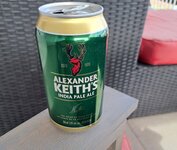DaveMatthews
Dave's not here. Cheating since 2018
- Region
- Canada
My red face gives it away.Don't you hate it when that happens?
That and the giggling...
My red face gives it away.Don't you hate it when that happens?










Still plenty of time yet Dave and the days are getting longer too. As for the fellow in distress, I think you did the right thing by playing the role of a good Samaritan. You could have easily ridden by and ignored his tantrum and despite his gruff demeanor it appeared that he appreciated your sincerity. Perhaps your random act of kindness won’t go unnoticed.On my way back from Tynehead park I happened across a rather sad looking fellow ebiker. He had it upside down on a sidewalk, and as I rode up to offer help I saw him kick his battery. Lol!
I asked him if there was something I could help with and he immediately went into an expletive laced tirade that would have made a Hell's Angel cringe.
In any case, apparently his bike just isn't reliable at all from a power perspective. Just keeps quitting on him.
His sleeves of tattoos of the devil, and skulls etc. along with his incessant swearing kept me sympathetic but cautious. Let's just say he's less than enamored with his Luna kit conversion.
He called a taxi. He thanked me for stopping and offering assistance. I left.
Beer time...
Thanks mate!Still plenty of time yet Dave and the days are getting longer too. As for the fellow in distress, I think you did the right thing by playing the role of a good Samaritan. You could have easily ridden by and ignored his tantrum and despite his gruff demeanor it appeared that he appreciated your sincerity. Perhaps your random act of kindness won’t go unnoticed.
Good to know. This will be our first June through August here. Temperatures are perfect for riding near the coast now. Guessing I'm gonna be missing that marine layer come late summer.My windows are about as far from the edge here as the lattice in the pic.
The marine layer can lay in thick here whlle a mile away the sun is shining. Especially when it is hot in the I5 corridor. Keeps the heat down though which I like. It was 70d and clear here a few weekends ago and 6 crow miles inland it was 95.
Fortunately the house is on solid Basalt erosion will take awhile.

AK Pale Ale FTW!First off a photo from the ranch house looking towards a gentle range of mountains called the Bobtails - over the past two years I'm getting to know many of the trails over this area. On the left side of photo notice the many solar panels providing energy to this off grid ranch. Today's ride was fun as I had my own support team although my dog left me for the comfort of the side by side. And of course the best part is an ale or two getting back home.View attachment 154667View attachment 154668View attachment 154669View attachment 154670
Looks delish!Hadn't paid much attention to the little French bistro close to our house till 2 days ago. What a mistake!
View attachment 154808
Most rides take me right past L'Atelelier de Paris. It's an easy 5 min from home by bike, the prices are reasonable, and it's casual and friendly. Turns out, they have a great all-day breakfast menu. With outdoor seating that lets me lock up my bike close by. (Still overly anxious about leaving it anywhere.)
View attachment 154809
Then there are the French pastries. This yummy apricot tart was half gone before I thought to take a photo for @Stefan Mikes , the mentor who taught me the importance of pastries in ebiking.
The Rook and I are going to be spending a lot of mornings and money here.
Even if you had already eaten a half of the tart, it does not look big to me judging by the American standards?Then there are the French pastries. This yummy apricot tart
I asked them to super-size it, but it comes in only one size, and I didn't have room to eat two.Even if you had already eaten a half of the tart, it does not look big to me judging by the American standards?
I really need to ride my Werk again. But still in a honeymoon phase with the new bike.This morning, Kathy and I went back to that little French bistro I wrote about yesterday. This time, I got some pictures.
View attachment 154927
The storefront doesn't look like much, but the food and pastries are great, and at 5 minutes from home, it couldn't be more convenient.
View attachment 154928
Could only lock the bikes together this time, as Kathy forgot her key. But our table was just on the other side of the fence, so secure enough for a worry-free breakfast. That Abus folding lock is probably the best security I'd be willing to carry, but what a royal PITA to deploy!
View attachment 154926
How could I not have noticed this logo before?? The name means "Paris workshop". All the savory crepes were named "Miss X", with X being some famous place on France's Mediterranean coast.
View attachment 154931
After breakfast, took an 8-minute jaunt to North Ponto beach to watch the waves. This is our quickest and easiest place to get up close and personal with the Pacific, as the surf's quite close to the Coast Highway here and only a little below road level. (Photo from a few days earlier.)
View attachment 154930
Ground squirrels work the beach and bluffs here. Fun watching mom and her 2 little ones scamper around less than 15 ft away.
View attachment 154929
The 13-second west swell coming in was too low to attract many surfers. This one didn't have much luck on his fancy foilboard. If that's not cutting-edge enough for you, you can now get electric foilboards.
American standards on the big size is usually not quality. One has to decide, tastes acceptable and fill up, or buy quality and feel just right.Even if you had already eaten a half of the tart, it does not look big to me judging by the American standards?
The beach looks like an excellent place for a tailgate a la ebike but with L’atalier nearby, it might be more favorable to eat there. Hope to see more savory items on the bistro menu on your next visit.The storefront doesn't look like much, but the food and pastries are great, and at 5 minutes from home, it couldn't be more convenient.